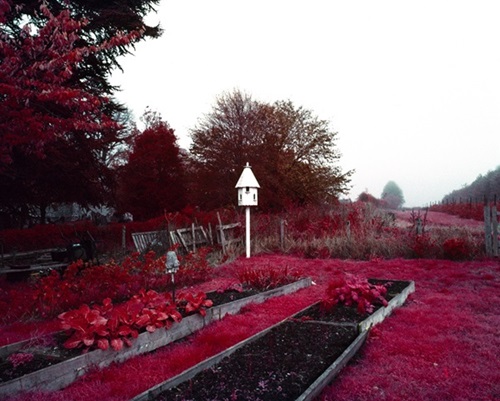Edition Details
- Published On :
- 07/26/2013
- Artwork Dimensions :
- 76 X 101 cm
Description
ED THOMPSON. Dovecote (The Village series), 2013. 101(w) x 76(h) cm. Digital C-type. Edition of 5. PRICE (INCLUDING VAT). £850.00. The large scale photographs in Ed Thompson’s recent series may at first glance seem as if they’ve been created with the help of a digital imaging program or a gimmicky phone app. However, The Unseen Project is an ongoing photo-series created with some of the last infra-red colour film ever produced. This is great news for anyone - including myself - who favours the creative process of making a photograph with real film and light rather than with the digital technology that has now monopolised the industry. Producing images like this without the use of digital enhancement takes real skill and dedication, which is a testimony to Thompson’s working practice. Once described by Germaine Greer as “the most single minded photographer” who “probably thinks about photography all the time, like a train spotter”, Ed gives each and every project he works on 100%, often changing the way he lives his life for long periods of time in order get the most involved that he possibly can in what he’s currently working on. Previous projects have seen him living in the US amongst the locals as a Texan hillbilly (these works can be seen on his Eyestorm page) and posing as an anarcho-dandy in London, all to get the best insight into the world he’s documenting at the time. With this current series, as well as using the infra-red film for what it was originally designed for, The Unseen Project also subverts the original intended purposes it was manufactured for as Ed explores the boundaries of our perception by attempting to document things that may usually escape our visual spectrum or those that go unnoticed or unreported. The normal visual wavelength of light for the human eye is between 400-700 nanometres. Infra-red film, however, records light between 750-1000 nanometres, ultimately allowing the ‘invisible’ to be photographed. This is therefore the perfect way to document the one-thousand-year-old rural village of Pluckley in Kent, reported as being the most haunted village in the UK, with 12 recorded ghosts, many tragic deaths and an endless amount of haunting tales associated with it. Although no ghosts appear in the photos, they’re charged with a physiologically disturbing filmic quality that makes a regular landscape appear like the scene of a crime or a set from a cult horror film. And when you know the story linked to each one this is only intensified. The House on the Hill image for example, which was used on the cover of the program for a photo-festival in Germany earlier this year, shows a house that sits near where an old windmill used to stand. Here a black silhouette - said to be that of the miller who hung himself in the mill - appears just before a thunder storm. Other stories include The Devil’s Bush - dance around it naked counter clockwise at midnight to summon Lucifer - and Park Wood, where a ghostly colonel who committed suicide on the land has been seen walking. The plot of land in Dovecote is located adjacent to the Parish Church of St Nicholas, where two ghosts - known as The Red Lady and the The White Lady - are said to haunt; The Red Lady, who is apparently buried at the church with a red rose in her coffin, wanders the churchyard while The White Lady’s restless soul is supposed to haunt the church itself. I’m not entirely familiar with the story of the creation of these works but I can imagine Ed spent a period of time staying in Pluckley while he worked on them. Whether he saw any ghosts or not I don’t know, but these photographs are certainly haunting in themselves. As we scan each image for that unexplained shadow or the sense of another presence, they have the ability to attempt to convert even the most stubborn of non-believers.

